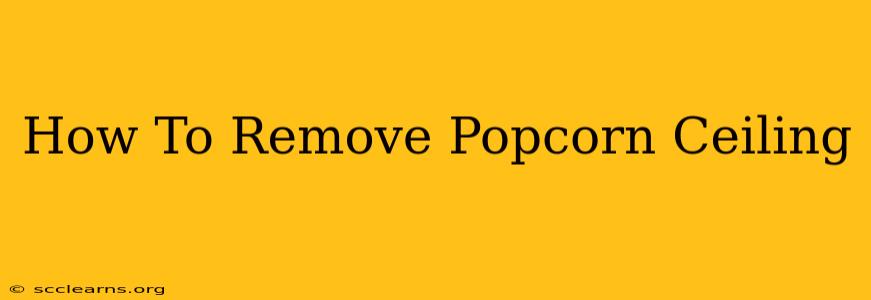Popcorn ceilings, once a popular choice for homeowners, are now often seen as outdated and even hazardous due to the potential presence of asbestos. Removing them can significantly improve your home's aesthetic appeal and potentially mitigate health risks. This comprehensive guide will walk you through the process of safely and effectively removing your popcorn ceiling.
Is Your Popcorn Ceiling Asbestos-Containing?
Before you even think about tackling this project, asbestos testing is crucial. Popcorn ceilings installed before 1978 often contain asbestos, a known carcinogen. Improper removal can release asbestos fibers into the air, posing serious health risks. Contact a professional asbestos abatement company to have a sample tested. Don't skip this step! The cost of testing is far outweighed by the potential health consequences of neglecting it.
Gathering Your Supplies: Preparing for the Removal
Once you've confirmed your ceiling is asbestos-free (or had professional abatement), you'll need these essential supplies:
- Safety Gear: This is paramount. You'll need a respirator (specifically designed for dust), safety glasses, gloves, and a dust mask. Consider a full-body suit for maximum protection.
- Tools: A scraper (preferably a wide, flexible one), a putty knife, a wire brush, a shop vacuum with a HEPA filter (crucial for containing dust), drop cloths, and plastic sheeting.
- Other supplies: A spray bottle filled with water, garbage bags for waste disposal, and primer and paint for the newly exposed ceiling.
Step-by-Step Popcorn Ceiling Removal Process
This process involves several careful steps to minimize dust and ensure a clean finish:
1. Preparation is Key:
- Protect your belongings: Cover your floors and furniture thoroughly with drop cloths and plastic sheeting. Seal off the room as much as possible to prevent dust from spreading to other areas of your house.
- Turn off power: Ensure that the power to the room is switched off to prevent electrical hazards.
2. Soak and Scrape:
- Wet the Ceiling: Lightly mist the popcorn ceiling with water using the spray bottle. This helps to dampen the texture and bind the dust, making removal cleaner and less messy.
- Scrape the Ceiling: Use your scraper to gently remove the popcorn texture. Work in small sections, applying consistent pressure. Be patient; this can be a time-consuming process.
3. Clean Up:
- Vacuum Thoroughly: After scraping each section, immediately use your HEPA-filtered vacuum to remove the debris. This prevents dust from settling and makes for a much easier cleanup later on.
- Dispose of Waste: Properly dispose of the removed material according to local regulations.
4. Surface Preparation:
- Clean the Ceiling: Once all the popcorn texture is removed, thoroughly clean the surface to ensure it’s free of dust and debris.
- Prime and Paint: After cleaning, apply a coat of primer to prepare the surface for paint. This will ensure better paint adhesion and a smoother, more even finish. Once the primer is dry, you can apply your chosen paint.
Should You DIY or Hire a Professional?
While removing a popcorn ceiling is a doable DIY project, particularly for smaller areas, consider the following:
- Size of the ceiling: Large ceilings require significantly more time and effort.
- Your DIY skills: This is a physically demanding job requiring patience and precision.
- Presence of asbestos: If asbestos is present, you must hire a licensed professional for abatement.
Hiring a professional ensures the job is done safely and efficiently, particularly when dealing with larger areas or potential asbestos.
Maximize Your Home's Value with a Fresh, Clean Ceiling
Removing your popcorn ceiling is an excellent way to modernize your home's look and improve its overall value. By following these steps and prioritizing safety, you can achieve a smooth, clean ceiling that enhances your home's beauty and creates a more comfortable living space. Remember, safety and proper preparation are key to a successful project!

